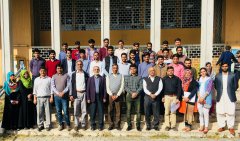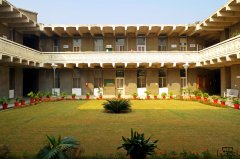|
EL-344
|
Microcontroller Interfacing
|
Credits: 3
|
|
Prerequisite: EL-221 (Digital Logic and Computer Architecture)
Course Outline:
Microcontrollers, peripherals, interfacing memory and I/O devices, microcontroller based hardware design, programmable logic devices, bootstrap loader design, programming peripheral devices, polling and interrupt based I/O interface (involves programming of embedded hardware), ADC interface with microcontroller using reference design of the controller, development of an embedded application (Project), PCB design and programming
|
|
Suggested Books:
1. Muhammad Ali Mazidi, Rolin D. McKinlay, PIC Microcontroller: Using Assembly and C for PIC18, (Pearson 2008).
2. J. Fluchen, An Introduction to Micro-computer System: Architecture and Interacting (Addison-Wesley 1990).
3. A. Mitchel, 32-bit Microprocessors, (McGrraw-Hill 1989).
4. Singh, 16-bit and 32-bit Micro-processor Architecture, Software, and interface Techniques, (Prentice-Hall 1991).
|
|
EL-391
|
Communication Laboratory
|
Credits: 1
|
|
List of experiments:
1. MATLAB® programming
2. Signal generation
3. Power spectral density
4. Basic channel impairment
5. Amplitude modulation
6. Angle modulation
|
|
EL-392
|
Analog Circuits Laboratory I
|
Credits: 1
|
|
List of experiments
1. Basic diode characteristics and biasing
2. Design of rectifier circuits (half and full wave rectifiers)
3. DC filters for rectifier circuits
4. Basics characteristics of Zener diode
5. Zener diode based regulation
6. BJT characteristics
7. BJT amplifiers
8. AC response of BJT amplifiers
9. FET characteristics and biasing
10. FET amplifiers
|
|
EL-393
|
Microcontroller Interfacing Laboratory
|
Credits: 1
|
|
List of experiments:
1. Assembly language programming and debugging
2. C and assembly language interface
3. Observing timing waveform and control signal
4. Communication with I/O devices in polling and interrupt mode
5. Direct memory access (DMA)
|
Semester-6
|
|
EL-350
|
Electronics II
|
Credits: 3
|
|
Prerequisite: EL-341 (Electronics I)
Course Outline:
Operational amplifier as a black box and its applications, cascade stages and current mirrors, design and analysis of differential amplifiers, high frequency models of BJT and FET, feedback and stability, oscillators, analog filters.
|
|
Suggested Books:
1. Behzad Razavi, Fundamentals of Microelectronics, 2nd edition, (John Wiley & Sons, Inc. 2013).
2. Adel S. Sedra, Kenneth C. Smith, Microelectronics circuits, 7th edition (Oxford university press 2014).
3. Donald A. Neamen, Microelectronics: Circuit Analysis and Design, 4th edition, (McGraw-Hill 2009).
|
|
EL-353
|
Signal Processing
|
Credits: 3
|
|
Prerequisite: EL-281 (Signal and Systems)
Course Outline:
Discrete-time signals and systems, LTI systems, systems characterized by difference equations, frequency domain, sampling of contineous time signals, reconstruction, up-sampling and down-sampling, Z-transforms and properties, applications to LTI systems, transform domain analysis of LTI systems, system function, rational system function, minimum phase and linear phase systems FIR filter design, fourier transform and fast fourier transform.
|
|
Suggested Books:
1. A. V. Oppenheim and R. W. Schafer, Discrete-Time Signal Processing, 3rd edition, (Pearson Higher Education Inc., 2010).
2. Ingle and Proakis, Digital Signal Processing using Matlab, 2nd edition, (Thomson-Engineering, 2006).
3. J. G. Proakis and D. G. Manolakis, Digital Signal Processing: Principles, Algorithms, and Applications, 4th edition, (Prentice Hall, 2007).
|
|
EL-394
|
Analog Circuits Laboratory II
|
Credits: 1
|
|
List of experiments:
1. Op-amps, characteristics of Op-amps
2. Applications of Op-amps.
3. Data converters (A/D and D/A)
4. Wave-shaping circuits
5. 555 Timer circuits
6. PLL
|
|
EL-352
|
Engineering Electromagnetics
|
Credits: 3
|
|
Prerequisite: EL-342 (Engineering Mathematics II)
Course Outline:
Static electric fields: Fundamental postulates, Gauss’s law, conductors and dielectrics in static electric fields, electric flux density, boundary conditions, electrostatic energy
Solution of electrostatic problems: Poisson’s and Laplace’s equations, method of images, method of separation of variables, method of moments, finite difference method, finite element method, boundary value problems
Steady electric currents: Current density and Ohm’s law, static magnetic fields, electromotive force, equation of continuity, boundary condition for current density
Static magnetic fields: Fundamental postulates, magnetic vector potential, magnetic dipole, magnetization, magnetic field intensity
Time varying fields and Maxwell equations: Faraday’s law, differential and integral forms of Maxwell equations, electromagnetic boundary conditions, wave equations and their solutions, time harmonic fields; Plane electromagnetic waves: Plane waves in lossless and lossy media, incidence at plane conducting and dielectric boundary, multiple dielectric interfaces
|
|
Suggested Books:
1. David K. Cheng, Field and wave electromagnetics, 2nd edition, (Addition-Wesley, New York, 2006).
2. Magdy F. Iskander, Electromagnetic fields and waves, 2nd edition, (Waveland Press, Inc. USA, 2013).
3. Simon Ramo, John R. Whinnery, Theodore V. Duzer, Fields and waves in communication electronics, 3rd edition, (John Wiley & Sons, Inc., 1994).
4. John D. Kraus and Daniel A. Fleisch, Electromagnetics with applications, 5th edition, (Mcgraw-Hill Series in Electrical Engineering, 2010).
|
|
EL-351
|
Digital Design using VHDL
|
Credits: 3
|
|
Prerequisite: EL-221 (Digital Logic and Computer Architecture)
Course Outline:
Introduction to electronic design automation (EDA), hardware modeling with the Verilog HDL, event-driven simulation and test bench, logic system, data types and operators for modeling in Verilog HDL, user define primitives, Verilog models of propagation delays, behavioral description in Verilog HDL, synthesis of combinational logic, synthesis of sequential logic, synthesis of language construct, switch-Level models in Verilog, UART design exercise, BIT-Slice AMD2901 microcontroller design exercise, rapid prototyping with Xilinx FPGA.
|
|
Suggested Books:
1. M.D. Ciletti, Modeling, Synthesis and Rapid prototyping with the Verilog HDL (Prentice-Hall 1999).
2. Samir Palnitkar, Verilog HDL, A guide to digital design and synthesis (Sun Microsystems 2003).
|
|
EL-397
|
VHDL Laboratory
|
Credits: 3
|
|
List of experiments:
1. Full adder/subtractor
2. Flip Flops
3. Up/down counter
4. shift register
5. multiplexer
6. NxM binary multiplier
7. random number generation
8. newspaper vending machine, traffic light controller
9. FIFO-Buffer for data acquisition
10. UART-Transmitter and receiver
|
Semester-7
|
|
EL-400
|
Project-I
|
Credits: 3
|
|
Prerequisite: None
Course Outline:
The objective of this course is to apply the theoretical and practical knowledge in the field of electronics by carrying out research and development based final year project design. The project consists of hardware/software implementation by going through research and development phases from inception to completion. The students are expected to clearly define the research and development problem by a presentation in order to proceed to the implementation phase (next semester).
|
|
EL-441
|
Electrical Machines
|
Credits: 3
|
|
Prerequisite: EL-342 (Engineering Mathematics II), EL-281 (Signal and Systems)
Course Outline:
Introduction to electrical machinery principles: Magnetic field and circuits, magnetization curves characteristics of hard and soft magnetic materials, losses
Transformers: Ideal transformer, single phase transformer, operation and equivalent circuit, auto-transformer
DC machinery fundamentals: Basics, loop rotating between pole faces, commutation, windings, armature reaction, induced voltage and torque equation, power flow and losses, types of DC motors, permanent magnet DC motors
AC machinery fundamentals: Rotating magnetic field, magneto motive force and flux distribution, induced voltage and torque, windings, power flow and losses, introduction to induction machines
Special Purpose Motors: Introduction to single phase induction motors, switched reluctance motors, hysteresis motors, stepper, brushless DC motors
|
|
Suggested Books:
1. Stephen J. Chapman, Electric Machinery Fundamentals, 4th edition, (McGraw-Hill 2005).
2. Fitzgerald, Kingsley and Umans, Electric Machinery, 7th edition,(McGraw-Hill 2013).
3. D. P. Kothari, I. J. Nagrath, Electric Machines, 3rd edition (McGraw-Hill 2004).
|
|
EL-404
|
Antennas and Wave Propagation
|
Credits: 3
|
|
Prerequisite: EL-352 (Engineering Electromagnetics)
Course Outline:
Theory and applications of transmission lines: Parallel plate transmission line, general transmission line equations, wave characteristics on finite transmission lines, transients on transmission lines, Smith chart, transmission line impedance matching
Waveguides and cavity resonators: Parallel plate waveguide, rectangular waveguides, circular waveguides, dielectric waveguides, cavity resonators
Microwave network analysis: Impedance and equivalent voltages and currents, impedance and admittance, scattering matrix, transmission matrix, signal flow graphs, discontinuities and modal analysis, excitation of waveguides
Antennas theory and radiating systems: Radiation fields of elemental dipoles, antenna patterns and antenna parameters, thin linear antennas, antenna arrays, internal impedance and directional pattern, effective area, back scattering cross section
|
|
Suggested Books:
1. Peter A. Rizzi, Microwave engineering: Passive circuits, (Prentice-Hall International, 1988).
2. David M. Pozar, Microwave engineering, 4th edition, (John Wiley & Sons, 2005).
3. David K. Cheng, Field and wave electromagnetics, 2nd edition, (Addition-Wesley, New York, 2006).
|
|
EL-403
|
Engineering Project Management
|
Credits: 3
|
|
Prerequisites: None
Course Outline:
Overview of project management: PMI process groups, software project phases, project charter, statement of work
Planning phase: Development lifecycle models, matching lifecycles to projects, project plans, work breakdown structures, estimation of effort and cost
Scheduling: Project network diagram fundamentals, CPM, PERT, Gantt charts, critical chain scheduling, using MS-Project, assigning resources, resource leveling, team models, managing conflict
Project monitoring and control: Status reporting, project metrics, EVM, communications Techniques
Risk management: Change control, project recovery, documentation, post project reviews, closing.
|
|
Suggested Books:
1. Bob Hughes, Mike Cotterell, Software Project Management, (McGraw Hill Higher Education, 2005).
2. Dwayne Phillips, The Software Project Manager's Handbook - Principles that work at work. 2nd edition, (IEEE Computer Society Press, 2004).
|
Semester-8
|
|
EL-401
|
Project-II
|
Credits: 3
|
|
Prerequisite: None
Course Outline:
The objective of this course is to apply the theoretical and practical knowledge in the field of electronics by carrying out research and development based final year project. The project consists of hardware/software implementation by going through research and development phases from inception to completion. The phase two of the project course emphasizes more on implementation/simulation focusing on the solution of the proposed problem. The completion requirements of the project include a demonstration/presentation and dissertation.
|
Elective Courses
|
|
|
EL-450
|
Information and Coding Theory
|
Credits 3
|
|
Prerequisite: None
Course Outline:
Elements of information theory: Entropy for discrete signals, randomness, self-information, mutual information entropy rate for Markov sources, bits and codes, compression, maximum entropy, mutual information
Source coding: Huffman coding, Shannon-Fano coding, Shannon's first theorem, channel capacity, entropy for continuous random variables, channel capacity, Shannon's second theorem, capacity of a band-limited Gaussian channel
Channel coding: Error correcting codes, linear block codes, cyclic codes, convolutional, codes, Viterbi's decoding algorithm, Hamming space, distance, code applications, Shannon's theory of information, coding theorem, converse, Shannon theory vs. Hamming theory, linear codes, asymptotically good codes, Limpel-Zev algorithm, Golay codes
Algebraic codes: Reed-Solomon, Reed-Muller, Hadamard, decoding of Reed-Solomon codes, Welch-Berlekamp algorithm, list decoding of Reed-Solomon codes, concatenated codes and decoding, maximum likelihood decoding.
|
|
Suggested Books:
1. Monica Borda, Fundamentals in information theory and coding (2011)
2. Todd K. Moon, Error Correction Coding: Mathematical Methods and Algorithms 1st edition, 2005.
3. Shu Lin, Daniel J. Costello Error Control Coding, 2nd edition, 2004
4. Martin Bossert, Channel Coding for Telecommunications, (Wiley 1999)
|
|
EL-451
|
Communication Systems
|
Credits: 3
|
|
Prerequisite: EL-281 (Signal and Systems)
Course Outline:
Significance of digital communication, overview of signals, spectra, probability and random variables, SNR and , sampling and quantization (uniform and non-uniform), signal to quantization noise ratio (SQNR), detection of a binary signal in Gaussian noise, matched filters and correlators, Baye’s decision criterion, maximum likelihood detector, error performance, inter-symbol interference (ISI), raised cosine pulse, eye-patterns, equalization techniques, vector representation of signals, Gram-Schmidt orthogonality principle, performance analysis of M-array signaling techniques
Error correcting codes: block codes, design and analysis of convolutional codes, advanced techniques for digital communication (e.g. DS-CDMA, FH-CDMA, OFDM, MIMO techniques)
|
|
Suggested Books:
1. B. P. Lathi and Zhi Ding, Modern Digital and Analog Communication Systems, 4th edition (Oxford University press, 2009).
2. B. Sklar, Digital Communication, (Prentice Hall 1988).
3. S. Haykin, Communication Systems, 4th edition, (John Wiley, 2000)
|
|
EL-460
|
Control Systems II
|
Credits: 3
|
|
Prerequisite: EL-340 (Control Systems I)
Course Outline:
Control of discrete processes, control of continuous processes, design of control systems PID controllers, lead lag compensators, pole-zero cancellations, introduction to digital control, practical systems, analog and microprocessor based control systems, design examples nonlinear control systems, optimal control theory, self-adaptive control systems, review of states space modeling, linearization of nonlinear systems, response of linear systems controllability and observability-concepts and tests, balanced realization/model reduction, introduction to robustness and performance tradeoff, state feedback and observer output feedback, innovation feedback and Q-parameterization, linear quadratic regulator (LQR), deterministic Kalman filter and LQG/LTR, trajectory tracking control, input shaping, internal model control and repetitive control , Lyapunov stability concepts, topic on nonlinear control
|
|
Suggested Books:
1. Ronald S. Burns, Advanced Control Engineering (2001)
2. Robert Bateson, Introduction to control system technology, (Prentice Hall 2001)
3. B. C. Kuo, Digital Control Systems (Wiley, 2010).
4. Slotine and Li, Applied Nonlinear Control, (Prentice Hall, 1991).
5. Richard C. Dorf, Robert H. Bishop, Modern Control Systems (Prentice Hall, 2010)
|









